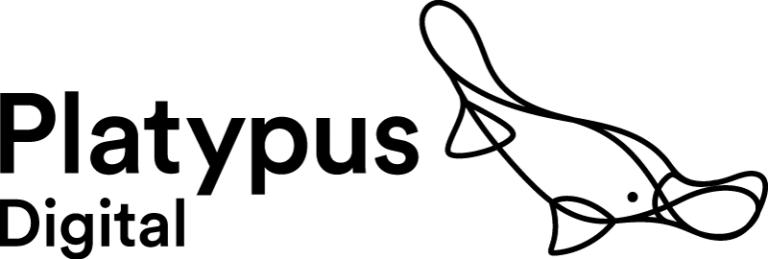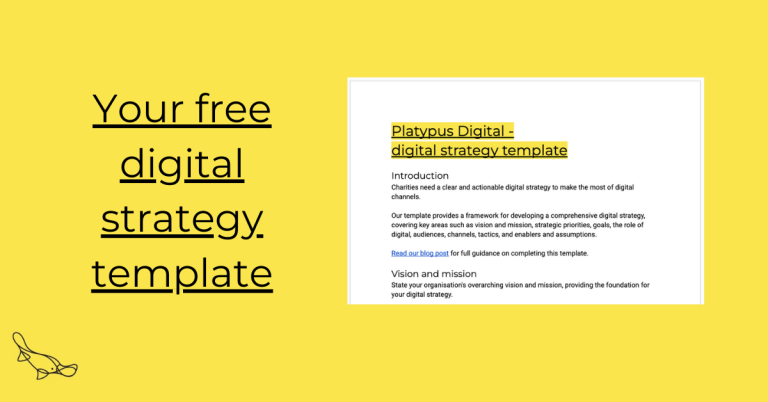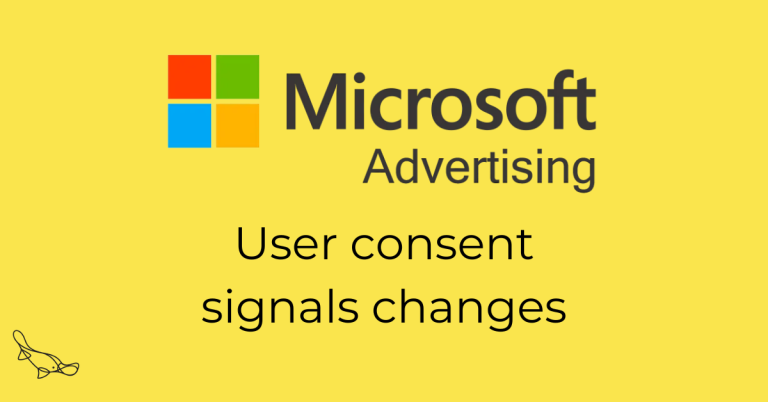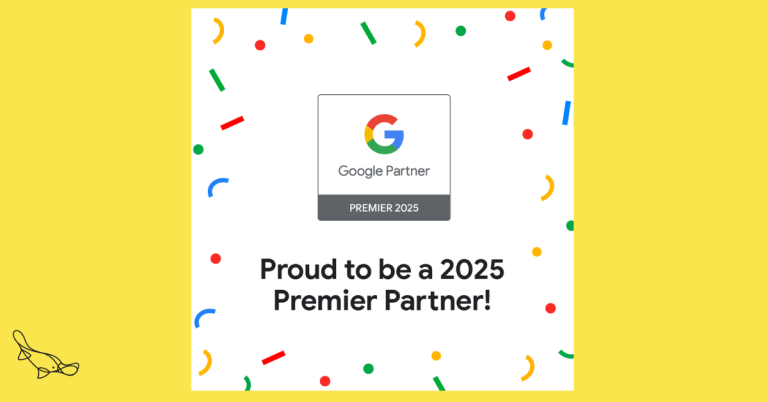What counts as a good charity digital strategy?
Depends who you ask of course, but we’ve seen and created a good few in our time.
We’ve drawn on this knowledge to create a free template for you to use to create your own.
Download our charity digital template.
Read the guidance and examples below before you start filling it in so you know exactly what to write.
We’ll use the example of a communications and marketing team for this document, as they manage the digital channels.
Vision and mission
If your vision is your why, and your mission is your what, your strategy is your how.
To ensure your strategy is aligned from the top levels of your organisation to your delivery and volunteer teams, it’s important to start by defining your mission and vision.
Your strategy tells you how you’re going to get there.
Example:
Our vision is a world where breast cancer won’t stop people from living healthy, full, long lives. We believe in a future free from the fear and impact of breast cancer, where individuals can thrive without the shadow of this disease.
Our mission is to prevent and cure breast cancer, focusing on groundbreaking research, preventive measures, and accessible treatments to fight breast cancer on every front.
Strategic priorities
Strategic priorities objectives serve as the pillars of our work, guiding our efforts and ensuring they contribute meaningfully to our mission. Strategic objectives govern the whole organisation, but there are usually a few that are more relevant to a team than others.
Specifically, for a breast cancer charity, the strategic objectives that may be the most relevant could be:
– Raising awareness of breast cancer and its symptoms. We want to demystify the disease and encouraging early detection.
– Funding programmes that support the screening, testing, and diagnosis of cancer. We want to drive donations through campaigns that highlight the importance and impact of these programmes, and allow people to participate in our journey in any way that suits them.
While there are broader objectives, such as fostering networks for organisational learning or leading on groundbreaking research, our focus is on those directly actionable through digital strategies.
Goals
Goals are the tangible milestones we set to track progress towards each strategic objective. Your strategic objective likely breaks down into key goals or OKRs (organisational key results). A KPI workshop will help you to identify and set these. Collectively, these should contribute towards your strategic objectives.
For example:
Strategic priority: Raise awareness of breast cancer
Goals:
– Increase digital impressions by 10% YOY
– Increase positive digital engagement on posts by 10% YOY
Strategic priority: Fund programmes that support the screening, testing and diagnosis of cancer
Goals:
– Drive 1200 donors from digital channels in 2024 (an increase of 5% YOY)
– Drive £50,000 in donations from digital channels in 2024 (an increase of 10% YOY)
You’ll notice we also included percentage growth goals. This is a good figure to include because it helps to anchor your targets on previous activity and ensures you’re not reaching for the stars – you want your goals to give you a sense of growth and achievement, but also to be attainable.
Ideally, these figures shouldn’t be based on guesswork or how other organisations perform. Reflect on how your previous activity has performed, both when you’ve invested in it and when you haven’t, and add a realistic figure (with some growth applied, reflective of the intention and investment you’re planning to put into this year’s activity) based on what you’ve seen.
KPIs should be SMART:
- Specific – they should be clearly defined and focused on a specific objective. When goals are too broad or vague, they are easy to miss.
- Measurable – it should be quantifiable using a clear, singular metric, and allow for comparison over time.
- Achievable – they should be realistic, and based on both current or previous performance and the level of resource available to achieve it
- Relevant – they should be tied with a strategic goal, so your achievement is directly related to your organisational success.
- Timebound – it should have a specific deadline, or period of time within which you hope to achieve it
The role of digital
It’s important to identify the specific role that digital plays in this area of work so that the team universally agrees on what you’ll use it for in this context.
Because digital is an enabler, it’s helping you to do things that you may not have been able to do offline or out of home. Now is a good time to formalise how you view the role of digital in achieving your mission, and define its scope so that you can limit any requests or work that you see to be outside the purview of your digital channels.
Example:
When we say digital, we mean:
– The digital channels we’ll use to communicate with our audiences. This specifically refers to our organic channels of Facebook, Twitter, Instagram, LinkedIn, email, and our website content, as well as paid channels like Meta and Google Search.
– The digital tools we’ll use to organise, track and measure our impact. This includes reporting tools like Google Analytics and Meta, our CRM, and our CMS.
Digital is going to help us expand our reach across the whole of the UK, engaging and informing people across the country in new and exciting ways and allowing them to take action on the things that matter most to them.
Digital will help us to keep our costs low while we test, scale and measure the success of our products. Access to digital data will help us to better analyse and make data-led decisions about our activity.
We’ll also use digital channels and platforms to learn more about what our supporters care about and what they’re likely to support.
Audiences
In this section, you’ll apply audience logic to your selection of channels and content.
Remember, you can’t really ‘target’ some channels the way you can with others, so keep this fairly broad and focused on audience needs and behaviour. You can also include demographics and behaviours where relevant to help you understand what channels you might be using and what content you might be producing and publishing.
Audiences don’t define themselves within singular buckets. A person might be a professional during the day, a patient in the evenings and a parent on the weekends, and this will affect how they might interact with you and on what channels.
We need to think about audiences in this section by identifying the characteristics that will define the sort of content we’ll put out.
Example:
Our audience are broadly people who are affected by breast cancer – whether they have been diagnosed with breast cancer, are at risk, or support a family member who has been diagnosed with and/or is receiving treatment for breast cancer.
Our immediate, first circle of audiences is most likely to be female. They’re the most likely to experience breast cancer, and therefore a lot of the content we’ll put out to these users is to give them clarity and assurance throughout their journey, which can be scary, overwhelming and confronting.
Our second circle is likely to come from broader walks of life. These people may be parents, partners, friends, workmates, daughters and sons who are supporting a family member throughout their journey. The content we’ll put out is to help them understand what their family member or friend might need from them throughout this journey, or give them a space to have their worries and fears assuaged.
Other audiences we will target on digital channels include funding partners, who will be looking to understand the value we’re able to drive through their funding. We’ll share things like statements and facts about our impact, case studies, and statistics that show the improvement of interventions.
We’ll also target healthcare professionals and researchers, who will be looking to us to provide updates about research, conferences, outcomes, and workplace guidance.
Channels
Here you’ll define the channels you’ll use to target some of the above audiences.
The interface of a channel can play a significant role in how it’s used – for example, a user will be much more likely to click on an ad they see on Facebook than TikTok. This will impact any expected conversion or engagement rates, so one might be more useful for your branded content, where they don’t have to leave the platform, and the other for your service or conversion content, where you’re looking to drive users to your page.
Remember – every channel has a different role to play. Different audiences exist on different channels and use them for different reasons. And people will likely interact with a brand or cause over multiple channels.
Example:
Facebook will be our general shopfront, but we’ll primarily use it to target people in the general public. Our first and second circle of audiences are both active here. Facebook is a strong conversion channel so it will be our primary channel for conversion asks like fundraising and lead generation. Due to the wide usage of Facebook we will also use it for our higher funnel, brand awareness content. This channel will be particularly relevant for our older audiences.
Instagram will be our storytelling channel. We’ll also use it to target people in the general audience, primarily our first and second circle of audiences. Generally content here will be developed for a younger, female audience, in line with the Instagram user base. Because Instagram is heavily discovery-based, we’ll use this channel to share information, data and updates for people who are looking for information.
LinkedIn will be used for our professional community. We’ll use it to promote things that are relevant to our healthcare, scientific and corporate partner community, such as updates about research, practitioner guidance, or updates about funding.
Tactics
In this section, you’ll break down the goals you identified into specific tactics. This helps you to identify specific levers you can pull to affect your targets.
A KPI workshop or sheet will help you identify some of these and ensure they align with your goals. This aims to ensure that your tactics, goals and objectives are aligned and that you’re identifying measurable ways in which you might achieve success.
Example:
Drive 1,200 donors from digital channels (an increase of 5%)
– Run 2x campaigns generating 200 donors each
– Run 2x challenge campaigns generating 400 donors each
Drive £50,000 in donations from digital channels (an increase of 10%)
– Sustain an average gift of £40 by:
- Developing a range of high-impact, compelling shopping list items ranging between £20 and £60
- Highlighting £50 as the recommended gift on the page
- Sustain a landing page conversion rate of 10% by:
- CRO testing the landing page to improve conversion
- Reducing form fields and unnecessary navigation from the landing page
Enablers and assumptions
So your strategy isn’t pie-in-the-sky, it’s important to list out any assumptions you might have made about the market or about the resources available to you that underpin this strategy.
This helps make sure that your team, and anyone responsible for signing this off, is aware of the things that need to be in place in order for you to secure your results.
Example:
We have made the following assumptions:
- That there won’t be significant entrants to the market for our audience in the next 12 months
- That the programmes we will be promoting will continue to be funded and run by our charity
The following enablers need to be in place, as agreed:
- We will recruit 1x digital marketing manager within the 23-24 FY
- We will have the support of 1x digital marketing agency within the 23-24 FY
- We will have a budget of £100,000 for media spend within the 23-24 FY
Appendices
Other things that might be useful to include as appendices, but not in the central body of your strategy:
- Competitor research
- Account audits
- KPI tables
A few things to remember
Your strategy isn’t intended to be a long, all-encompassing document. A strategy should give shape, but not colour.
Details of content, copy, key messages, or specific audiences (things that can change campaign to campaign or month to month, depending on decision-making about propositions and campaigns) should go into your campaign plans or other planning documents, not your strategy.
While your organisational strategy may only change every 3-5 years, you should refresh your function strategy every 6-12 months. Because the digital landscape changes quickly, you may find that the goals or tactics you set won’t be as relevant in 12 months as they are now, or that you didn’t get the results you needed to hit your goals.
You need to reassess your tactics to see if there are other avenues you can explore, or that you accounted for investment that you couldn’t secure.
We recommend doing this alongside a retrospective and ideally an in-depth quantitative assessment of your last reporting period.





